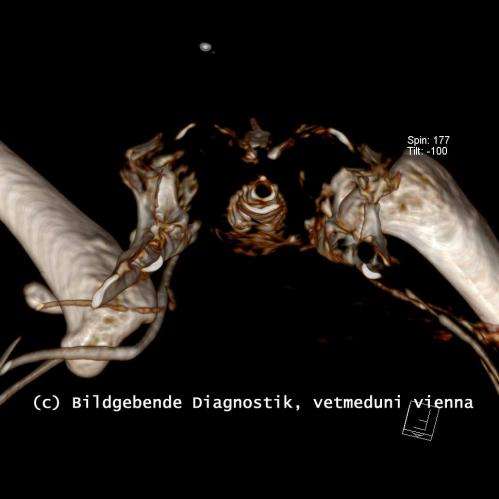Crash landings

Despite – or perhaps because of – their large size, swans seem particularly prone to injury. Known problems include collisions with cars, lead poisoning due to gunshot wounds or ingested foreign bodies and injuries from fishing hooks. Injuries to the birds' hips, however, are believed to be uncommon. Michaela Gumpenberger and Alexandra Scope of the University of Veterinary Medicine, Vienna now present evidence to suggest that such injuries are more frequent than suspected but are under-recorded because of difficulties in diagnosis. They show that computerized tomography is far better suited to examine the hip joint than classical radiographic methods. Their results are published in the journal Avian Pathology.
Diagnosing an injury in a swan is a far from easy undertaking. Not only are swans large, frequently weighing over 10 kg, but they are generally not happy at being handled and thus many of them can only be examined after sedation, which naturally represents a risk. The hip joints of many species of bird are known to be vulnerable to injury but swans are believed to suffer broken hips only rarely. The traditional way of examining the birds' hips relies on radiography but Gumpenberger and Scope now show that computerized tomography (CT) gives more reliable findings.
The researchers examined the hip joints of five swans that had been brought to the Clinic for Avian, Reptile and Fish Medicine of the University of Veterinary Medicine, Vienna because they were unable to stand. Radiographs were taken of three of the birds, while all of them were subjected to CT scans. The results were highly illuminating. Radiography gave indications that one of the swans might have problems with its hip joint but the diagnosis was not conclusive and the other two swans examined seemed to have intact joints. In contrast, CT showed correctly that all five swans had lesions of the hip.
Computerized tomography is thus much better able to identify problems with the hip joint than classical radiographic methods. In addition, it is often less stressful for the animals: imaging can be performed without the need for narcosis by simply placing the bird in a darkened cardboard box and allowing it to sit comfortably, whereas radiography of many species requires their sedation.
It seems, then, that hip problems in swans are more common than previously believed. It is likely that the majority of injuries of this kind arise when the birds attempt to land on hard surfaces, when the landing forces are transmitted through their legs to their hips. Of course, such emergency landings may simply be the result of air turbulence but Gumpenberger notes that "many injured swans are found near roads or railway lines, so it is possible that they misinterpret shiny rails or even concrete road surfaces as being water and thus try to land."
The paper "Computed tomography of coxofemoral injury in five mute swans (Cygnus olor)" by Michaela Gumpenberger and Alexandra Scope is published in the journal Avian Pathology (Vol. 41(5), 465-468).
More information: www.tandfonline.com/doi/abstra … 03079457.2012.712205
Provided by University of Veterinary Medicine -- Vienna
















